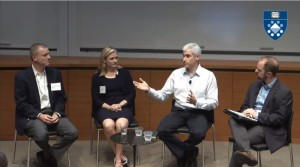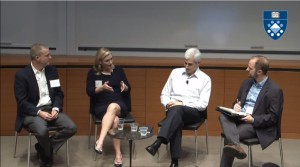Unilever and NRG Energy Set Joint Renewable-Energy Goals

On May 7, 2014, Unilever and NRG Energy announced the formation of a strategic partnership. The goal? To source 100 percent of the energy used by Unilever’s United States operations from onsite and offsite renewable generation by 2020.
During a recent two-day conference, managers from both companies reflected on the progress they’ve made and the lessons they’ve learned during the past year. The conference was jointly hosted by Yale Center for Business and the Environment, United States Business Council for Sustainable Development, and World Business Council for Sustainable Development. The highlights of the discussion are outlined below this video of the event.
The Origins of the Partnership
How does one of the largest multinational consumer goods companies decide to partner with a Fortune 500 electricity business to completely revamp its energy usage across North America?
Well, if the Unilever-NRG Energy collaboration is any guide, they make the decision quite quickly. In December 2013, the two CEOs met for the first time to explore the possibility of a large-scale partnership related to clean energy. Less than six months later, Unilever announced its collaboration with NRG Energy.
Of course, it helped that both companies were already committed to becoming leaders in the sustainable business space. In 2010, for example, Unilever unveiled its Sustainable Living Plan, which ambitiously set targets of doubling its growth and halving the environmental impact of its products by 2020. Four years later, David Crane – NRG Energy’s CEO – made headlines when he pledged to reduce his company’s carbon emissions 50 percent by 2030 and 90 percent by 2050.
It became increasingly clear to Unilever that its bold dreams would require even bolder actions.
Prior to the NRG Energy deal, Unilever’s United States sites had already offset their entire electricity use with renewable energy certificates (RECs). But the company knew that it would have to go beyond RECs if it wanted to play a transformative role in the clean-energy market.
Hurricane Sandy also made a strong business case for setting big goals in the distributed renewable energy arena.

“Our headquarters in New Jersey were shut down for about two weeks,” said Jonathan Atwood, vice president of Sustainable Living and Corporate Communications at Unilever. “It started this conversation about [how] we can’t have that happen again. There’s a real risk here.”
At the same time, NRG Energy was struggling to find the big demand for renewable energy that would help catalyze its transition away from coal.
Ultimately, Unilever had the demand that NRG Energy was looking for, and NRG Energy had the capacity to bring Unilever’s clean energy vision to scale. To quote Andrew Winston, a business writer who helped facilitate the partnership between these two companies: It was truly a “meeting of minds.”
The Results of the Announcement
At one point during the event, Atwood joked: “I initially thought that the press release was the hardest part. I’ve been proven wrong.”
NRG Energy and Unilever formed and announced their collaboration in record time. However, neither company knew exactly how they were going to achieve Unilever’s goal of 100 percent renewable energy by 2020.
“We set it before we actually knew how to get there,” Atwood said. “And that’s kind of, I would say, customary of Unilever, where we set targets that are pretty far out there, we don’t really know how to get there, and then we go out looking for partners that can get us there.”
The “getting there” hasn’t been easy. The two representatives noted that their companies only just signed a master power purchase agreement (PPA) this summer.
But the pace of their progress reflects the complexity of the challenges faced by both companies.
“[Initially], I thought that: if we just put a solar panel on every roof of every building we have, this story will be over and we can keep moving,” Atwood said. “If we did that, I think we’d get to 5 percent. So, we were going to be a little short with that mentality.”
Instead, Unilever is taking a portfolio approach. It will rely on a variety of clean energy technologies and energy-saving projects to reach its 2020 target. At the moment, everything is up for consideration, including – but not limited to – wind, solar power, energy efficiency, combined heat and power, changes to employee benefit plans, and making electric vehicle charging available to all of Unilever’s United States employees.
Ultimately, however, both representatives stressed that the goal is to achieve cost neutrality – or better – across their whole energy portfolio.
“We’re not in the same ROI conversation, the classic: Does it pay back in three, four, five years?” Atwood said. “This has to end in savings. This is not a charitable or philanthropic effort. So, throughout this portfolio approach, the end result will be a savings to Unilever.”
The financing, however, gets complicated quickly.
“I thought that the two companies could talk at a portfolio level across a number of facilities more easily than they [actually] could,” Winston said. “In reality, each project… had its own economics.”
Lynda Clemmons, managing director at NRG Energy, agreed. “You have to go in and you have to do a pretty significant analysis,” Clemmons said. She added that the math is tricky because “Unilever has very strategically placed their plants in low-cost environments.”
The Challenges and Benefits of Collaborating at Scale
To collaborate at this scale, both companies have had to change. In the case of NRG Energy, developing a comprehensive energy portfolio for Unilever required new levels of intra-firm communication.
For example, Clemmons highlighted the challenges of structuring contracts across sets of technologies that span multiple and often independent organizations within NRG Energy. These organizations may include the renewable energy group, the non-renewable distributed generation group, the various energy efficiency groups, etc..
In many respects, the partnership has pushed Unilever into uncharted territory.
“We’ve never signed anything that long in Unilever’s history,” Atwood said, referring to the master PPA with NRG Energy. He added that moving the partnership forward required “a period of education” within Unilever, since the deal involved not only Unilever’s finance and sustainability divisions, but also staff in the procurement, communications, legal, and environmental health and safety departments.
Strong leadership from the top was critical to overcoming these obstacles to collaboration.
“The two CEOs get together once a quarter,” Atwood said. “They have the support teams with them, but the two leads actually have a conversation about… Are we clear on the objective? Where are we on track? Where are we off track? What do we need to do? What we can do as the leaders to move things out of the way to keep us moving in the right direction?”
While both managers were quick to underscore the difficulties of collaborating at scale, they were just as quick to highlight the benefits of their partnership.
Clemmons called the collaboration “a tremendous catalyst” for NRG Energy. The company has since signed renewable energy deals with Kaiser Permanente and Starwood Hotels & Resorts.
Atwood noted that activity on the partnership and on the Sustainable Living Plan has generated “a real buzz among a lot of different functions and people, particularly a lot of the younger employees.”
“Words are words,” he said, referring to Unilever’s public pledges to sustainability. “What they can see is different.”
And what Unilever’s employees are increasingly seeing is action.
The Potential for Growth
Clearly, Unilever United States and NRG Energy have an ambitious goal to reach during the next several years. However, Atwood said collaborations between NRG Energy and Unilever would expand beyond their current partnership.
“We’ve created this in the United States,” Atwood said. “It has not been re-created elsewhere yet. But I think one of the interesting parts of the conversation is that Unilever typically will want to go to scale or will want to share great ideas elsewhere… My prediction is that you will see NRG and Unilever do other things together outside of the United States.”
“I want to say that by 2030 we’ll be off the grid,” Atwood said.
Note: Yale Center for Business and the Environment co-hosted this conference. Stuart DeCew, who is in a management role at the Clean Energy Finance Forum, participated in the panel discussion.
Join our LinkedIn group to discuss this article. You may also email the author directly using our contact form.
